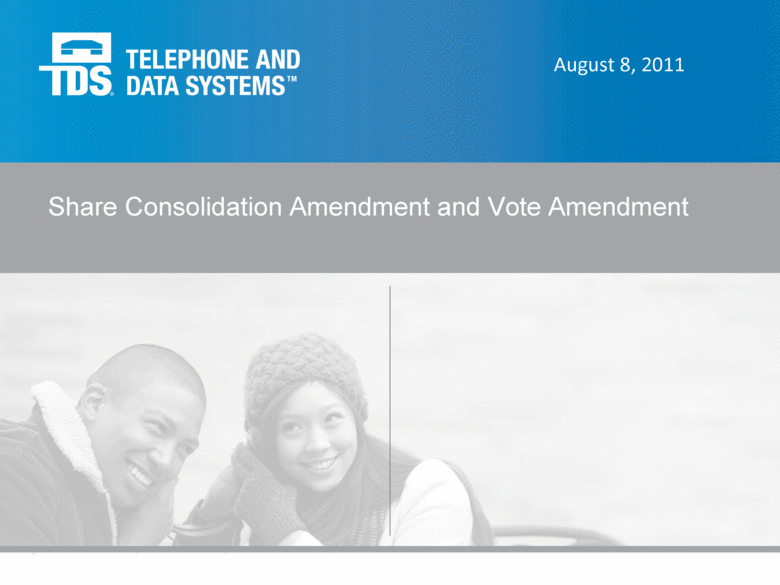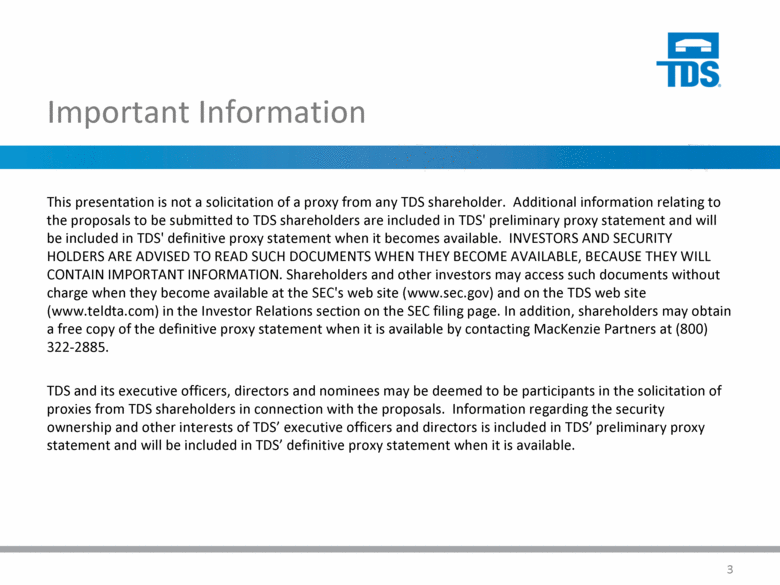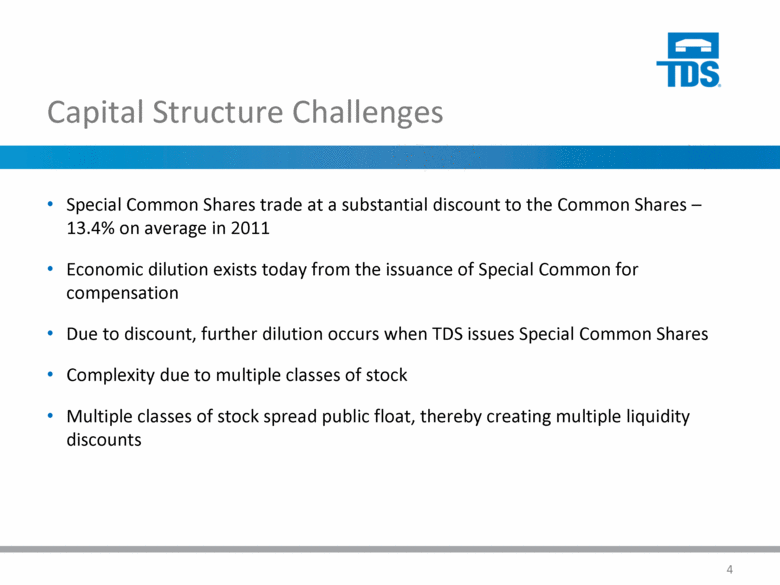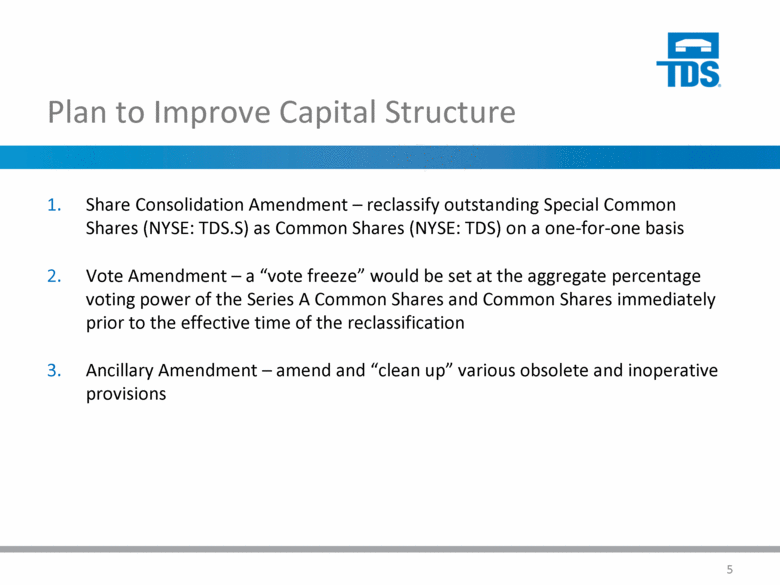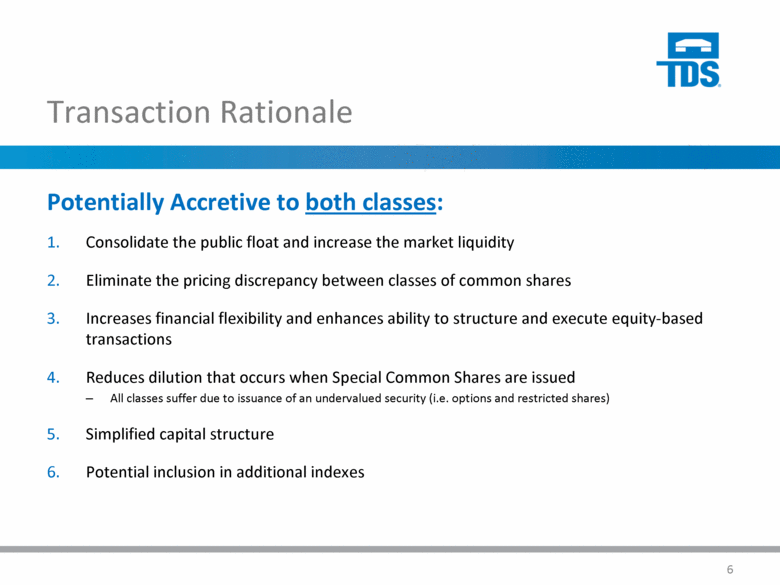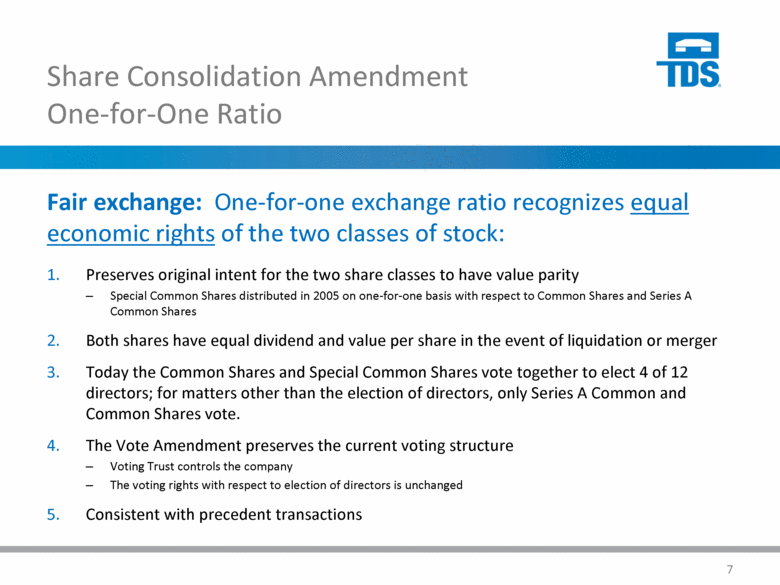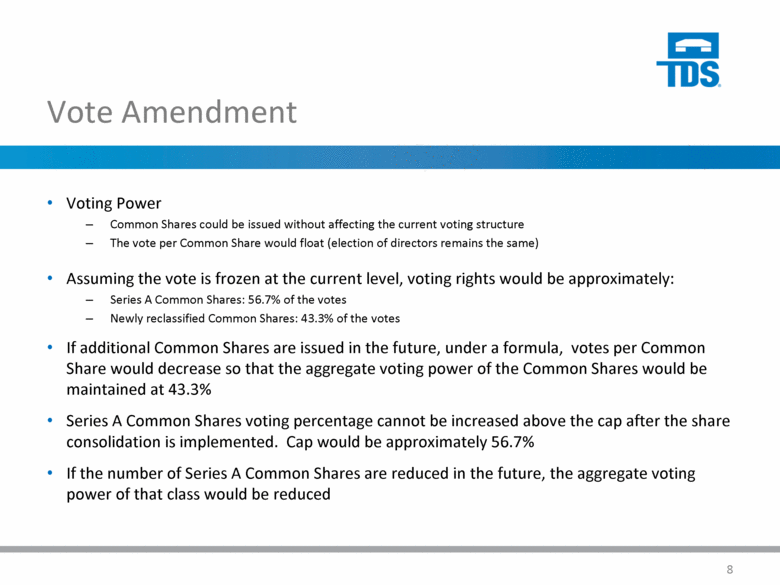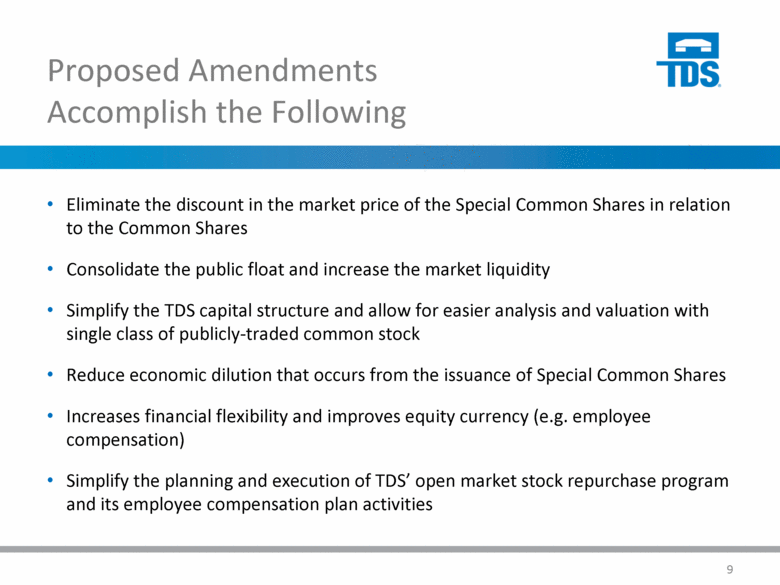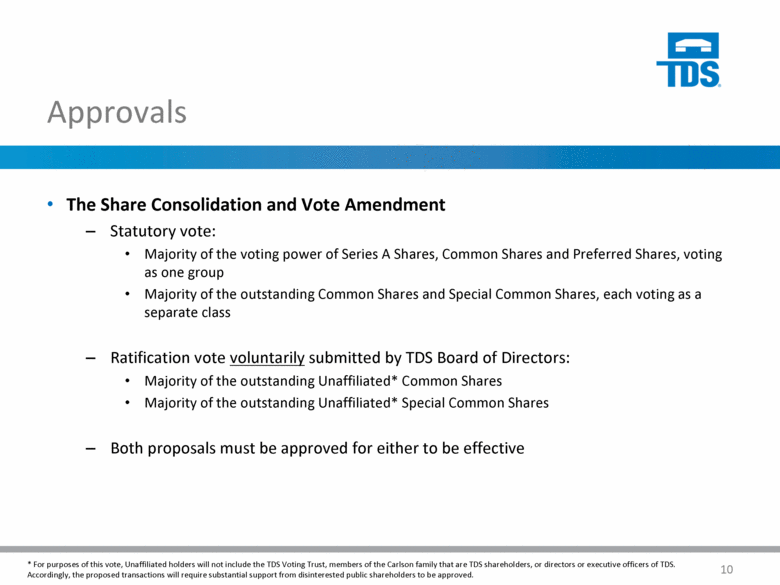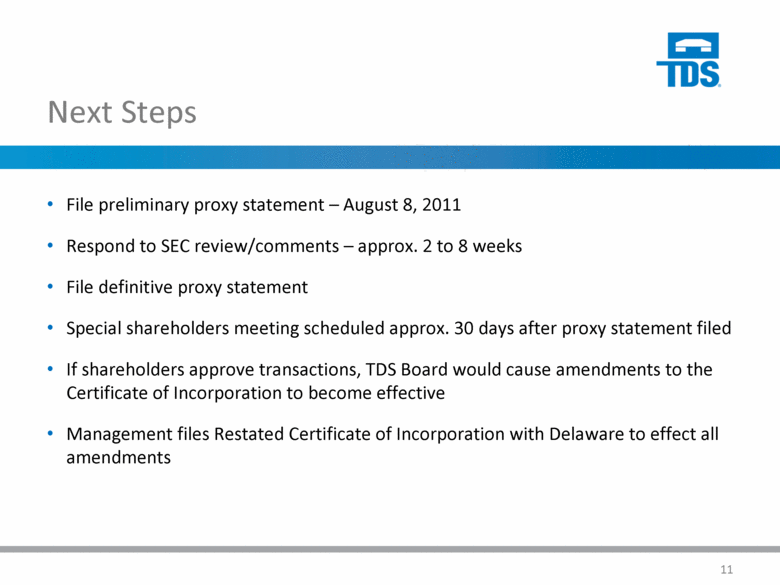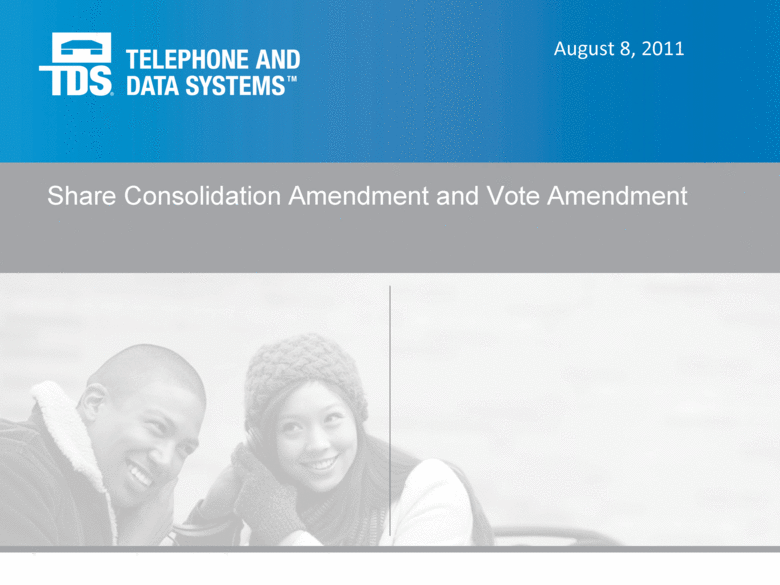Attached files
| file | filename |
|---|---|
| 8-K - 8-K - TELEPHONE & DATA SYSTEMS INC /DE/ | a11-21461_88k.htm |
| EX-99.1 - EX-99.1 - TELEPHONE & DATA SYSTEMS INC /DE/ | a11-21461_8ex99d1.htm |
| EX-99.4 - EX-99.4 - TELEPHONE & DATA SYSTEMS INC /DE/ | a11-21461_8ex99d4.htm |
| EX-99.3 - EX-99.3 - TELEPHONE & DATA SYSTEMS INC /DE/ | a11-21461_8ex99d3.htm |
Exhibit 99.2
|
|
Share Consolidation Amendment and Vote Amendment |
|
|
Safe Harbor Statement Under the Private Securities Litigation Reform Act of 1995: All information set forth in this presentation, except historical and factual information, represents forward-looking statements. This includes all statements about the company’s plans, beliefs, estimates and expectations. These statements are based on current estimates, projections and assumptions, which involve certain risks and uncertainties that could cause actual results to differ materially from those in the forward-looking statements. Important factors that may affect these forward-looking statements include, but are not limited to: the ability of the company to successfully grow its markets; the overall economy; competition; the access to and pricing of unbundled network elements; the ability to obtain or maintain roaming arrangements with other carriers; the state and federal telecommunications regulatory environment; the value of assets and investments; adverse changes in the ratings afforded TDS and U.S. Cellular debt securities by accredited ratings organizations; industry consolidation; advances in telecommunications technology; uncertainty of access to the capital markets; pending and future litigation; changes in income tax rates, laws, regulations or rulings; acquisitions/divestitures of properties and/or licenses; and changes in customer growth rates, average monthly revenue per unit, churn rates, roaming revenue and terms, the availability of handset devices, or the mix of products and services offered by U.S. Cellular and TDS Telecom. Investors are encouraged to consider these and other risks and uncertainties that are discussed in documents filed with the SEC. 2 |
|
|
Important Information This presentation is not a solicitation of a proxy from any TDS shareholder. Additional information relating to the proposals to be submitted to TDS shareholders are included in TDS' preliminary proxy statement and will be included in TDS' definitive proxy statement when it becomes available. INVESTORS AND SECURITY HOLDERS ARE ADVISED TO READ SUCH DOCUMENTS WHEN THEY BECOME AVAILABLE, BECAUSE THEY WILL CONTAIN IMPORTANT INFORMATION. Shareholders and other investors may access such documents without charge when they become available at the SEC's web site (www.sec.gov) and on the TDS web site (www.teldta.com) in the Investor Relations section on the SEC filing page. In addition, shareholders may obtain a free copy of the definitive proxy statement when it is available by contacting MacKenzie Partners at (800) 322-2885. TDS and its executive officers, directors and nominees may be deemed to be participants in the solicitation of proxies from TDS shareholders in connection with the proposals. Information regarding the security ownership and other interests of TDS’ executive officers and directors is included in TDS’ preliminary proxy statement and will be included in TDS’ definitive proxy statement when it is available. 3 |
|
|
Capital Structure Challenges Special Common Shares trade at a substantial discount to the Common Shares – 13.4% on average in 2011 Economic dilution exists today from the issuance of Special Common for compensation Due to discount, further dilution occurs when TDS issues Special Common Shares Complexity due to multiple classes of stock Multiple classes of stock spread public float, thereby creating multiple liquidity discounts 4 |
|
|
Plan to Improve Capital Structure Share Consolidation Amendment – reclassify outstanding Special Common Shares (NYSE: TDS.S) as Common Shares (NYSE: TDS) on a one-for-one basis Vote Amendment – a “vote freeze” would be set at the aggregate percentage voting power of the Series A Common Shares and Common Shares immediately prior to the effective time of the reclassification Ancillary Amendment – amend and “clean up” various obsolete and inoperative provisions 5 1. 2. 3. |
|
|
Transaction Rationale Consolidate the public float and increase the market liquidity Eliminate the pricing discrepancy between classes of common shares Increases financial flexibility and enhances ability to structure and execute equity-based transactions Reduces dilution that occurs when Special Common Shares are issued All classes suffer due to issuance of an undervalued security (i.e. options and restricted shares) Simplified capital structure Potential inclusion in additional indexes 6 Potentially Accretive to both classes: 1. 2. 3. 5. 6. – |
|
|
Share Consolidation Amendment One-for-One Ratio Preserves original intent for the two share classes to have value parity Special Common Shares distributed in 2005 on one-for-one basis with respect to Common Shares and Series A Common Shares Both shares have equal dividend and value per share in the event of liquidation or merger Today the Common Shares and Special Common Shares vote together to elect 4 of 12 directors; for matters other than the election of directors, only Series A Common and Common Shares vote. The Vote Amendment preserves the current voting structure Voting Trust controls the company The voting rights with respect to election of directors is unchanged Consistent with precedent transactions 7 Fair exchange: One-for-one exchange ratio recognizes equal economic rights of the two classes of stock: 1. 2. 3. 4. 5. – – – |
|
|
Vote Amendment Voting Power Common Shares could be issued without affecting the current voting structure The vote per Common Share would float (election of directors remains the same) Assuming the vote is frozen at the current level, voting rights would be approximately: Series A Common Shares: 56.7% of the votes Newly reclassified Common Shares: 43.3% of the votes If additional Common Shares are issued in the future, under a formula, votes per Common Share would decrease so that the aggregate voting power of the Common Shares would be maintained at 43.3% Series A Common Shares voting percentage cannot be increased above the cap after the share consolidation is implemented. Cap would be approximately 56.7% If the number of Series A Common Shares are reduced in the future, the aggregate voting power of that class would be reduced 8 – – – |
|
|
Proposed Amendments Accomplish the Following Eliminate the discount in the market price of the Special Common Shares in relation to the Common Shares Consolidate the public float and increase the market liquidity Simplify the TDS capital structure and allow for easier analysis and valuation with single class of publicly-traded common stock Reduce economic dilution that occurs from the issuance of Special Common Shares Increases financial flexibility and improves equity currency (e.g. employee compensation) Simplify the planning and execution of TDS’ open market stock repurchase program and its employee compensation plan activities 9 |
|
|
Approvals The Share Consolidation and Vote Amendment Statutory vote: Majority of the voting power of Series A Shares, Common Shares and Preferred Shares, voting as one group Majority of the outstanding Common Shares and Special Common Shares, each voting as a separate class Ratification vote voluntarily submitted by TDS Board of Directors: Majority of the outstanding Unaffiliated* Common Shares Majority of the outstanding Unaffiliated* Special Common Shares Both proposals must be approved for either to be effective 10 * For purposes of this vote, Unaffiliated holders will not include the TDS Voting Trust, members of the Carlson family that are TDS shareholders, or directors or executive officers of TDS. Accordingly, the proposed transactions will require substantial support from disinterested public shareholders to be approved. — — — |
|
|
Next Steps File preliminary proxy statement – August 8, 2011 Respond to SEC review/comments – approx. 2 to 8 weeks File definitive proxy statement Special shareholders meeting scheduled approx. 30 days after proxy statement filed If shareholders approve transactions, TDS Board would cause amendments to the Certificate of Incorporation to become effective Management files Restated Certificate of Incorporation with Delaware to effect all amendments 11 |
|
|
Summary At TDS, we understand that we have certain strategic, operational and structural opportunities and challenges. Management, with the support of the Board, is working to address these with a sense of urgency. Today’s proposal represents an important step toward improving our capital structure and enabling us to move forward with other strategic initiatives. 12 |
|
|
Share Consolidation Amendment and Vote Amendment |

